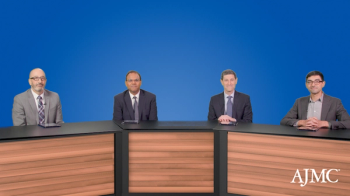
Switching to Appropriate Guideline-Directed Therapy to Improve HF Patient Outcomes
Experts discuss improving outcomes for patients with heart failure through appropriate and timely switches to ARN inhibitors.
Ryan Haumschild, PharmD, MS, MBA: Are you seeing hospitalists looking to switch from that ACE [angiotensin-converting enzyme] or ARB [angiotensin receptor blockers] to an ARNI [angiotensin receptor-neprilysin inhibitor]? Or are they waiting for it to happen in outpatient clinic in the follow-up visit?
Rohit Uppal, MD, MBA, SFH: As was mentioned earlier, adoption hasn’t been as brisk as we’d hoped in the inpatient or outpatient setting. What I’d say about the inpatient setting is that we know that these transitions of care are always risky. On the one hand, if we start a medication in the hospital, our patients are much more likely to adhere to that therapy. On the other hand, there’s always uncertainty about the level of monitoring and the safety and feasibility of doing this shortly after an exacerbation. Those questions aren’t often answered in clinical trials.
Luckily, we have a recent trial, the TRANSITION trial (NCT02661217), that helped answer that question around safety, and that’s going to give hospitalists much more confidence that we can initiate these medications early and do it safely once our patients with heart failure have stabilized. That’s a great opportunity for us to optimize their care. It means that hospitalization can be one of those key touch points where physicians can make sure that patients are getting that goal-directed therapy that’s going to improve their outcomes, reduce readmissions, and, importantly, reduce mortality.
Ryan Haumschild, PharmD, MS, MBA: Awesome. Dr Januzzi, I want to hear some final thoughts from you. As the specialist, what improved outcomes do you see if a patient has already been switched to the appropriate guideline-directed medical therapy [GDMT] prior to being referred to you as a specialist for follow-up?
Jim Januzzi, MD: That’s a great question. Let’s think about the timeline of improvement. As Dr [John E.] Anderson said, you see reductions in N-terminal-proBNP within a matter of days of being switched to sacubitril/valsartan, and that early drop in NT-proBNP is predictive of improved health status as well as improved ejection fraction [EF] in the months of follow-up. The improvement continues well after these therapies are started. For example, in the PROVE-HF study (NCT02887183), we showed that the average ejection fraction improvement in someone treated with sacubitril/valsartan was around 5% by 6 months, and it went up to 9.4% by a year after being started.
You can tell your patients that you can continue to expect ongoing improvement, and this isn’t just with drugs like sacubitril/valsartan. With well-dosed beta blockers, you see very similar benefits. With SGLT2 inhibitors, we recently showed that the NT-proBNP reductions continue out to a year after being started on empagliflozin, and improvements in health status extend well beyond that time. It isn’t just the early wins of getting people onto guideline-directed medical therapy; it’s also the yards after the catch. Make sure that you continue to optimize care, focus on lifestyle, adjust therapies to control diabetes and blood pressure if it still remains elevated on GDMT, and focus on the whole patient rather than just these 4 medications.
Ryan Haumschild, PharmD, MS, MBA: Dr Januzzi, you’re familiar with the PARAGON trial (NCT01920711). It evaluated the use of ARNIs in patients with heart failure with preserved ejection fraction. How do you apply the results of that trial to your patients when you’re selecting treatments? If you could, talk about some of the limitations of the trial that you think about when you’re treating your patients.
Jim Januzzi, MD: PARAGON is one of the more discussed studies in recent memory because it had some curious results that have led to a lot of debate. At a high level, looking at it from a frequentist statistics perspective, the study was neutral. It barely missed its primary end point of cardiovascular death and total heart failure hospitalizations with a p-value of 0.059.
When you take a step back and look at the results of PARAGON, you can look at it from 2 different ways. On the one hand, you could say that it’s a neutral study and we aren’t going to overinterpret the results. On the other hand, to the extent that the result of the trial was driven by only 7 events in 1 arm, you have to take a step back and ask yourself whether it was more that there was more modest reduction in events overall.
That said, are there populations within this study that got more benefit than others? If you look at it from that perspective, there are some very important observations. Women had a strong reduction in cardiovascular events when treated with sacubitril/valsartan for their heart failure and ejection fraction above 45%. It includes some of the mildly reduced population all the way up to the normal range. In addition, if you look at just the ejection fraction, if you start looking at patients with an EF of 55% or lower, the benefit is clear in both women and men.
The bottom line is that it has led us to start thinking more on an individualized level when we’re considering the use of sacubitril/valsartan for treating heart failure, and the guidelines reflect this. It makes the point that for people with a frankly normal ejection fraction, it’s a class 2B recommendation. Essentially, it seems like there’s benefit, but for those with an EF of 55% or greater, it may be best used in women and probably not in men. On the other hand, for people with an ejection fraction less than 50% into that mildly reduced population, the guidelines are much more permissive. They say it’s probably worthwhile to use the drug in that setting. That middle group is where I individualize care. In my patients with heart failure with an ejection fraction between 50% and 55%, I typically use sacubitril/valsartan, but I definitely use it in women in that setting and in people who have been hospitalized.
Transcript edited for clarity.
Newsletter
Stay ahead of policy, cost, and value—subscribe to AJMC for expert insights at the intersection of clinical care and health economics.










































